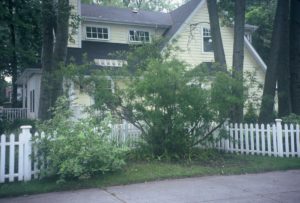
Typical white picket fence
Although many landscapes have beautifully designed planting plans, creativity seems to be lacking when it comes to designing the fencing. We are used to seeing picket fences, stockade fences, split rail fences, and perhaps, even bentwood fences but why do those types of fences have to be the only ones we use? Why are the designs always vertical? And why are they always white, black, or gray?

A blue metal door and Eco-Mesh fence in a Virginia suburb
A woman who used to be in manufacturing took materials with which she was familiar and made them into something special. She used royal blue Eco-Mesh, wire mesh and frames that are powder coated in a wide variety of colors. It can be used for plant facades, screens, trellises and more that are strong and sustainable but she used it to create a tall fence that separates her driveway from her backyard.

The orange fence will provide color all year round.
One of ONLA’s award-winning landscape designers sparked a commercial landscape with a fence composed of orange metal panels. How’s that for something different?

This fence divides the house and pool from the beach beyond.
A modern take on the picket fence, particularly appropriate for a contemporary house, would be a fence composed of steel rods. This would only work where division of space is the issue rather than privacy.

A stand of dwarf bamboo echoes this Asian themed fence that is partially composed of bamboo.
Vertical fences such as the frequently used board on board are incredibly boring. Why not add another material to make the fence more interesting? We’re always looking for materials that will last so why not use bamboo which is rot and pest resistant? In an oriental-style garden, a fence that intersperses wood boards with bamboo stalks creates a study in textural contrast.

The lattice topper provides something onto which the Sweet Pea tendrils can cling.
It seems to me that a fence of horizontal design would greatly enhance a small space because it would give the illusion of greater width. I’ve encountered this type of fence made of irregular boards in England and here in the States, usually with a lattice topper.

This lovely horizontal fence was designed by Deborah Silver of Detroit Garden Works.
The typical bentwood fence is made out of relatively thick branches but one I saw in Detroit was more like woven willow. It was very graceful but also provided total privacy.
In my travels, I’ve seen an infinite variety of fences. These are only a few of the more unusual ones. I hope you will be inspired to install one in your landscape.


0 Comments